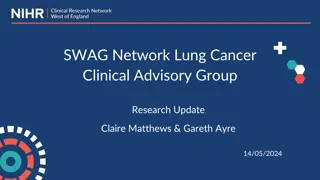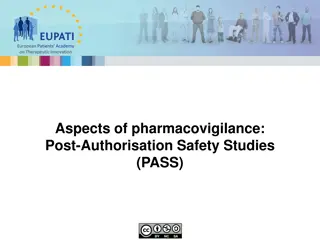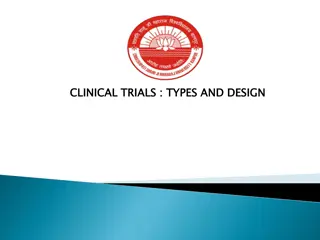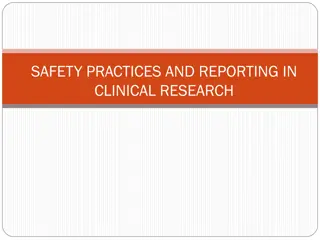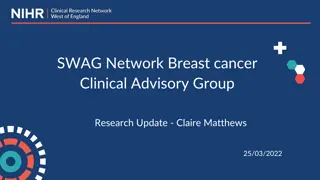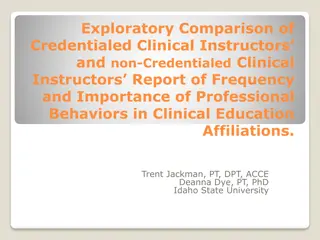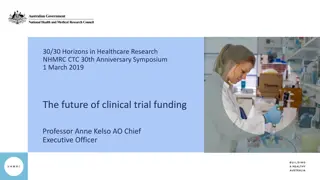
Understanding Non-Clinical Development in Pharmaceutical Industry
Explore the process of non-clinical development in the pharmaceutical industry, covering aspects such as pre-clinical research, safety assessment, regulatory guidelines, and the importance of early evaluations. Learn about in silico, in vitro, and in vivo studies, and how they contribute to determining the efficacy and safety of new drug candidates before clinical trials.
Download Presentation

Please find below an Image/Link to download the presentation.
The content on the website is provided AS IS for your information and personal use only. It may not be sold, licensed, or shared on other websites without obtaining consent from the author. If you encounter any issues during the download, it is possible that the publisher has removed the file from their server.
You are allowed to download the files provided on this website for personal or commercial use, subject to the condition that they are used lawfully. All files are the property of their respective owners.
The content on the website is provided AS IS for your information and personal use only. It may not be sold, licensed, or shared on other websites without obtaining consent from the author.
E N D
Presentation Transcript
Contents: 1. Introduction 2. Investigational New Drug (IND) 3. New DrugApplication (NDA) 4. Abbreviated New DrugApplication (ANDA) 5. Investigation of Medicinal ProductsDossier (IMPD) 6. Investigator s Brochure (IB)
INTRODUCTION: The non-clinical (or pre-clinical) development phase primarily aims to identify which candidate therapy has the greatest probability of success, assess its safety, and build solid scientific foundations before transition to the clinical development phase. Also, during the non-clinical development phase, the candidate compound should meet non-medical objectives, including defining the intellectual property rights and making enough medicinal product available for clinical trials. The non-clinical development of a medicine is complex and regulatory-driven.
The studies in non-clinical development are performed: In silico: performed on computer or via computer simulation , e.g. predicting the toxicology profile of a product using its chemical structure from data-based approaches. In vitro (Latin for within the glass ): performing a procedure in a controlled environment outside of a living organism, e.g. use of hepatocyte (cells from the liver) cultures for metabolism studies. In vivo (Latin for within the living ): experimentation using a whole, living organism as opposed to tissues or cells, i.e. animals, humansor plants.
Objectives: Once a candidate compound is identified, the non- clinical development should start answering the following questions, and answers assessments/studies: Does it work? efficacy assessment How will it be delivered and how will the body react? profiling Is it safe? toxicology/safety Is the manufactureviable andcontrollable? Non-clinical development activities can continue throughout the life-cycle of the product, although the earlier these questions are answered, the easier it is to identify the profile of the patient who will benefit most. will come from specific
Non-clinical regulatoryguidelines; There are development of medicines, and each institution follows their own set of rules. For instance, companies have their Standard Operating Procedures (SOP). many players in the involved organisation or In addition to Good Clinical Practice provisions, guidelines can be consulted at the European Medicines Agency (EMA) website. They are either general or more specific addressing scientific and technical aspects (e.g. specific to required toxicology studies). They must be strictly followed for any new marketing authorisation application; must be justified. any deviation
INVESTIGATIONAL NEW DRUG (IND) Investigational New Drug is defined under 21 CFR 312.3(b) as a new drug or biological drug that is used in clinical investigation . The term also includes a biological product used in-vitro for diagnostic purposes. After pre-clinical investigations when the new molecule has been screened for pharmacological activity and acute toxicity potential in animals the sponsor requires permission from FDAfor its clinical trials in humans.
The sponsor submits the application for conduct of human clinical trials called Investigational New Drug (IND) application to FDAor DCGI . Once IND application is submitted , the sponsor must wait for 30 days before initiating any clinical trial. Clinical trials in humans can begin only after IND is reviewed by the FDA and a local institutional review board (IRB). IRBs approve clinical trial protocol, informed consent of all participants and appropriate steps to prevent subjects from harm.
TYPES OFINDs A. COMMERCIAL INDs These are applications that are submitted primarily by the companies to obtain marketing approval for a new product. B. NONCOMMERCIAL (Research)INDs These INDs are filed for noncommercial research. These are : 1) Investigator s IND- It is submitted by a physician who both initiates and conducts an investigation and who also administers and dispenses the IP. A physician might submit a research IND to propose studying an unapproved drug or an approved drug for new indications or in new patient population.
2) Emergency Use IND This IND allows FDA to allow the use of an experimental drug in an emergency situation that does not allow submission of an IND in accordance with 21 CFR Sec312.23 or Sec 312.34. It can also be used for patients who do not meet the criteria of an existing study protocol or if an approved study protocol does not exist. 3) Treatment IND-Also called Expanded Access IND This IND may be submitted for experimental drugs showing promise in clinical testing of immediately life threatening conditions while the final clinical work is conducted and the FDA review takes place (21 CFR 312.34). serious and
Criteria forIND application Anew indication Change in the approved route of administration or dosage level. Change in the approved patient population (vulnerable subjects e.g. pediatrics, elderly, HIV +ve, immunocompromised) Significant change in the promotion of an approved Drug.
NEW DRUGAPPLICATION(NDA) The New Drug Application is the vehicle through which the drug sponsors formally propose FDA or DCGI to approve a new investigational drug for sale and marketing after PhaseIIIA Pivot trials. The official definition of New Drug is in Sec 201(p) of Federal Drug, Food and CosmeticsAct as; Any new drug , the composition of which is such that it is not recognized among experts qualified by scientific training as safe and effective for use under prescribed, recommended or suggested conditions.
Any drug the composition of which is such that it as a result of investigations to determine safety and efficacy for use has become recognized, but which has not, otherwise in such investigations been used to a material extent. The following letter codes describe the review priority of the drug; S-Standard review: For drugs similar to currently available drugs P-Priority review: For drugs that represent significant advancesover existing treatments.
Classification of drugs in NDA Center of drug classifies new drug applications according to the type of drug being submitted and its intended use: a. New molecular entity b. New salt of previously approved drug c. New formulation of previously approved drug d. New combination of two or more drugs e. Already marketed drug product- Duplication (i.e., new manufacturer) f. New indication (claim) for already marketed drug (includes switching marketing status from prescription to OTC) g. Already marketed drug product ( no previous approved NDA) S evaluation and Research(CDER)
ABBREVIATED NEW DRUGAPPLICATION (ANDA) . Generic drug applications are referred to Abbreviated New DrugApplication. Pharmaceutical companies must admit ANDAs and receive FDA s approval before marketing new generic drugs according to 21CFR 314.105(d). Once ANDA is approved, an applicant can manufacture and market generic drug to provide safe, effective and low cost alternative of innovator drug product to the public. Generic drugs are termed abbreviated as they are not required to include preclinical and clinical data to establish safety and efficacy. They must scientifically demonstrate Bioequivalence to Innovator (brand name) drug.
Ageneric drug is comparable to Innovator drug I dosage form, strength, route of administration, quality, performance and intended use. One of the ways to demonstrate bioequivalence is to measure the time taken by generic drug to reach bloodstream in 24-36 healthy voluanteers. The time and amount of active ingredientsa in the bloodstream should be comparable to those of Innovator drug. Use of bioequivalence as base for approving generic drug products was established in 1984, also known as WAXMAN-HATCH ACT. It is because of this act that generic drugs are cheaper without conducting costly and duplicative clinical trials.
INVESTIGATION OFMEDICINAL PRODUCTS DOSSIER (IMPD) The IMPD is the basis for approval of clinical trials by the competent in the EU. The Clinical Trial Directive came in force harmonizing the laws, regulations and administrative provisions of the Member states relating to the implementation of GCP in the conduct of clinical trials on medicinal products for human use. The directive introduced a harmonized procedure for the authorization to perform a clinical study in any one of the EU Member States.
In addition, it defines the documentation to the documentation to be submitted to the Ethics Committee as well as the IMPD to be submitted to the competent authority for approval. Dossier; Acollection of documents about a particular person, event or subject. E.g. Patient s medical record Medicinal product dossier; File containing detailed records about a particular drug product.
Objectives: Since clinical trials will often be designed as multi center studies, potentially involving different Member States, it is the aim of this guideline to define harmonized requirements of the documentation to be submitted throughout the European Country.
INVESTIGATOR'S BROCHURE The Investigator's Brochure (IB) is a compilation of the clinical and nonclinical data on the investigational product(s) that are relevant to the study of the product(s) in humansubjects. Purpose: Its purpose is to provide Information to the Investigators and others involved in the trial such as the dose, dose frequency/interval, methods of administration, and safety monitoring procedure. The IB also provides insight to support the clinical management of the study subject during the course of the clinical trial.
The information should be presented in a concise and simple manner. IB enables a clinician or potential investigator, to understand it and make his/her own unbiased risk benefit assessment of the appropriateness of the proposed trial. For this reason, a medically qualified person should generally participate in the editing of an IB.
General Considerations: Title Page 1. Sponsor name 2.The identity of each investigational product (i.e., research number, chemical or approved generic name, and trade name(s) where legally permissible and desired by the sponsor). 3. The release date. 4. Confidential statement
Confidentiality Statement The sponsor may wish to include a statement instructing the investigator/recipients to treat the IB as a confidential document for the sole information and use of the investigator's team and the IRB/IEC. The investigatorbrochureshouldinclude: 1.Tableof Contents 2.Summary 3.Introduction 4.Description of IB 5.Nonclinical Studies 6. Effects in Humans 7. Summaryof Data andGuidance for the Investigator.

